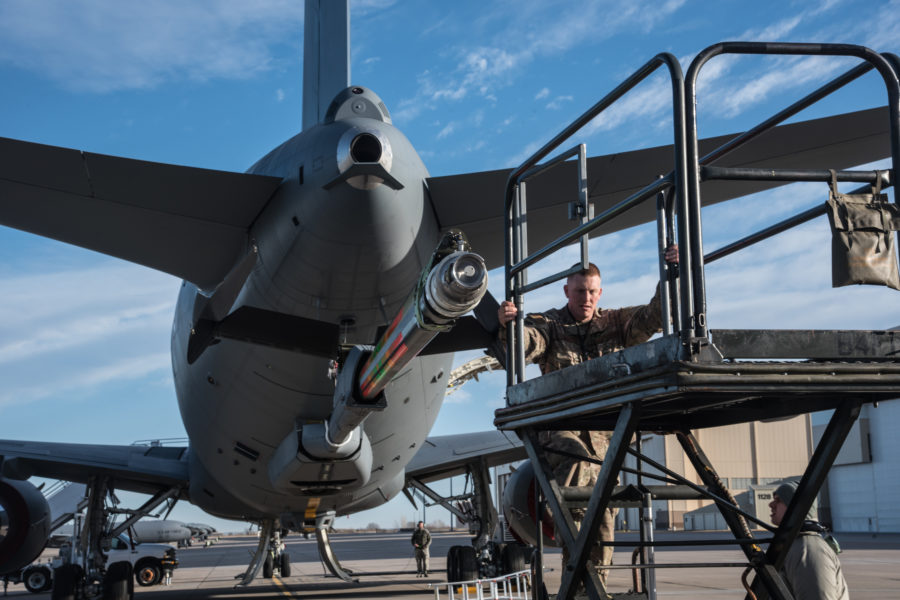While Boeing and the Air Force inch forward on the new KC-46 Remote Vision System 2.0, they are also making progress on other deficiencies that have thus far limited the aircraft in certain missions.
Boeing is tweaking the design of the actuator at the base of the tanker’s boom so that it will operate with the thrust-limited A-10 Thunderbolt.
The Pentagon Inspector General characterized the problem as a “stiff boom” that “would not extend or retract during flight testing unless subjected to more force” than the A-10 could muster. Rather than a full “boom redesign,” Boeing KC-46 Program Manager James Burgess said the fix is a new actuator.
Speaking to reporters at Boeing’s Everett, Wash., plant, Burgess explained the challenge this way: The actuator “drives the boom out in the telescope direction, and then when a receiver connects with it, the receiver drives the boom back into sort of a nominal refueling position.” The original actuator requires about 1,400 pounds of pressure to enable refueling, Burgess said. But when at high altitude and fully loaded with weapons, the A-10 is “a very thrust-limited receiver aircraft; it had trouble pushing it up to that 1,400 pounds and then keeping it compressed at that force.”
Indeed, A-10 attack aircraft still cannot refuel from the KC-46, even after Air Mobility Command announced in September that the KC-46 had been cleared for worldwide deployments and combatant commander taskings.
The new actuator will be able to better regulate the force needed. Boeing shared a 3-D model of the new design in the boom assembly facility.
“What it does is control force as a function of rate, so as the receiver pushes harder on it, it pushes back harder on the receiver,” Burgess said. “If the receiver doesn’t push as hard on it, it doesn’t push as hard back. So it’s a little bit more conducive to lightweight, thrust-limited receivers like the A-10.”
The new actuator is smaller than the current one, and simpler, as well, with only one torque motor rather than two.
“It turns out [the current actuator] was probably a little over-designed initially in terms of redundancy,” Burgess said. “That has nothing to do with the deficiency. But Boeing and the Air Force worked together to take advantage of simplifying the design as part of the redesign. The relief manifold assembly … goes away, and it’s replaced with what’s called a PQ valve.”
A working version of the new actuator is currently going through lab tests at Boeing Field, Burgess said. Delays, however, continue to mount: An Air Mobility Command spokesperson told Air & Space Forces Magazine in November that the fix, referred to as the Boom Telescoping Actuator Redesign (BTAR), “is experiencing delays due to issues getting a compliant actuator from Boeing’s subcontractor, Moog.”
AMC said its most recent projection has flight testing ending in late 2023, with retrofits for the existing fleet starting in late 2025. Delays could push that still further into the future.
The “stiff boom” is just one of several non-RVS deficiencies in the KC-46 identified by the Air Force. Another is related to leaks in the fuel system that were first identified in March 2020. Reports indicated seals designed to “flex” and move with the aircraft were insufficient to the task. Burgess said the problem was due to the difficulty of installation, and that Boeing has since redesigned the valve seals to make it easier to install them. As a result, “far fewer” fuel leaks have been reported, Boeing and Air Force officials during the plant visit.
Officially, the leaking seal deficiency has not yet been resolved, but Burgess said that was more of a formality at this stage, the result of infrequent meetings of the KC-46 deficiency board.
Other deficiencies have been resolved. Burgess touted during the tour the redesigned cargo pallet lock, which now includes a safety feature to ensure the lock stays fully engaged. The previous design sometimes unlocked when twisted during flight, leading the Air Force to restrict the aircraft from carrying cargo or passengers for a few months in 2019.
All in all, Air Force officials projected optimism, both in the KC-46’s current capabilities and the future fixes coming.
“If we had to go to war today, we would take this airplane with us,” Lt. Col. Joshua M. Renfro, from the Air Force’s KC-46 Cross Function Team, told reporters. “And we’d be fantastically confident in its capabilities in order to deploy it. However, long term, there’s always things that we can leverage— emerging technologies, and that partnership [with Boeing]—to acquire what the long-range vision for this tanker needs to be.”

